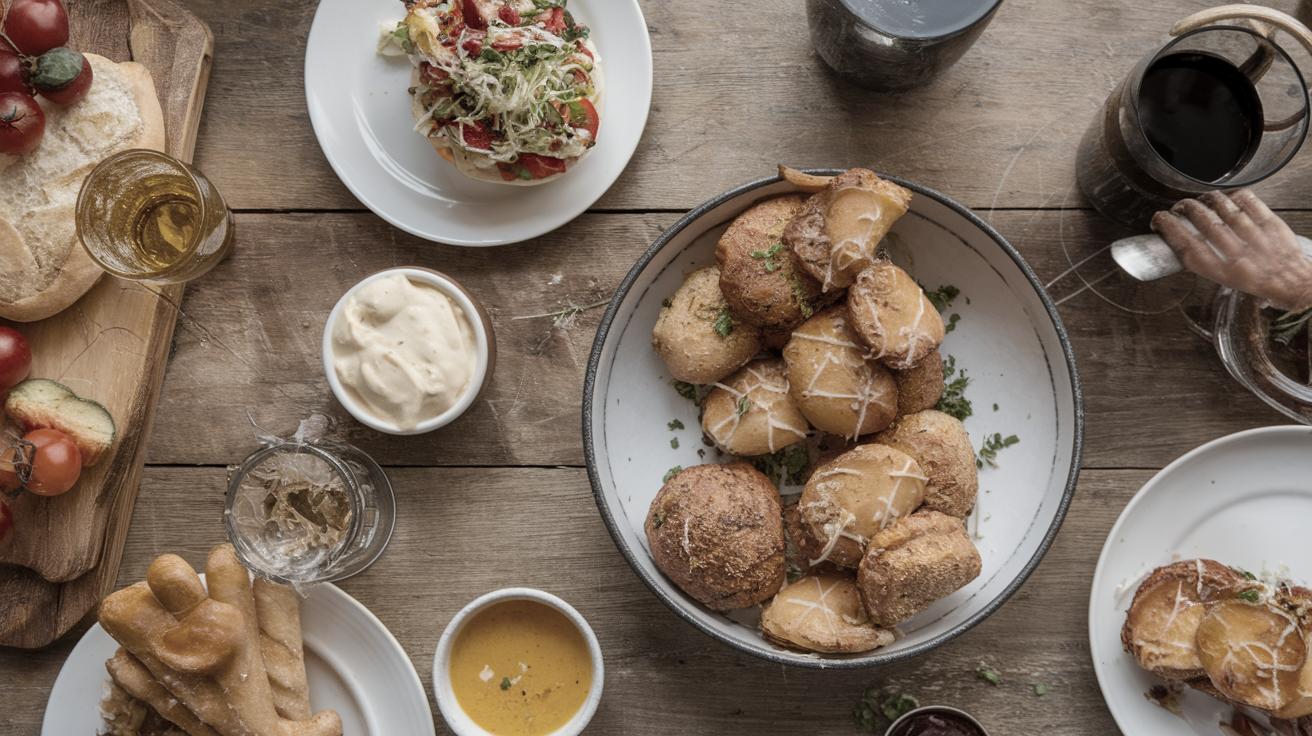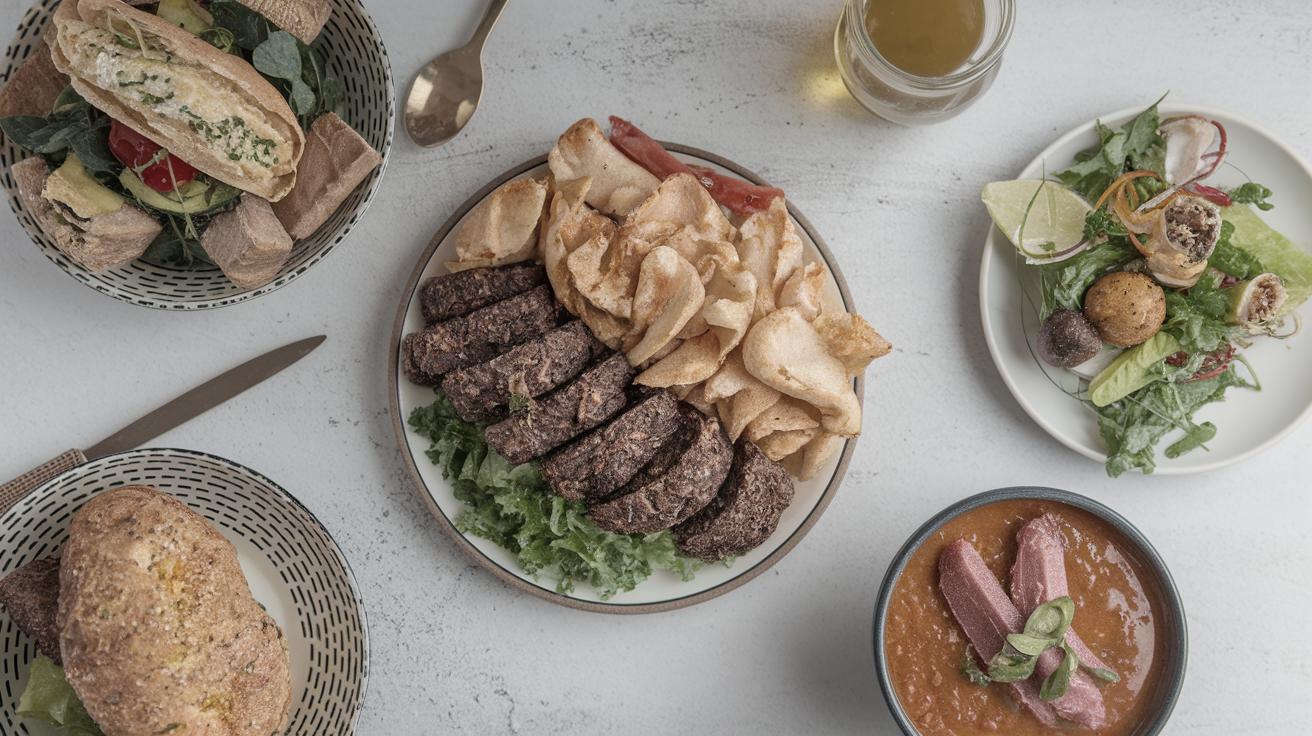What Food is Spain Known For
Spain, a country of diverse landscapes and rich culture, is equally known for its vibrant and flavorful cuisine. With a history that spans centuries, Spanish food is a tapestry of regional dishes, traditional ingredients, and culinary innovations. From the savory dry-cured Jamón Ibérico to the beloved, sweet churros, Spanish cuisines like paella, tortilla de patatas, and gazpacho have crossed borders to become global favorites. The essence of Spanish dining lies in its passion for fresh, quality ingredients and communal eating, perfectly exemplified by the popular tradition of tapas. In this exploration, discover Spain’s iconic dishes, each with its own story, flavors, and cultural significance that help define the country’s rich gastronomic heritage.
1. Jamón Ibérico
Jamón Ibérico, or Iberian ham, is arguably one of Spain’s most renowned culinary achievements. This delicacy, derived specifically from Iberian pigs, is celebrated for its rich and complex flavors, a result of the pigs’ unique diet of acorns and their later curing process. The curing of Jamón Ibérico can take from two to four years, creating a melt-in-your-mouth experience with delicate marbling and a pristine balance of taste.
The process of producing Jamón Ibérico is steeped in tradition and adheres to strict regulations, ensuring its highest quality. Different regions offer varying flavors of this ham, with the color and aroma reminding one of its deep connection to the Spanish countryside. Tasting Jamón Ibérico is more than just an act of eating; it is an encounter with Spain’s ancient culinary customs that celebrate the craftsmanship passed down through generations.
2. Tortilla de patatas
A staple in Spanish households, Tortilla de patatas, or Spanish omelette, showcases the simplicity and deliciousness of Spanish cooking. This dish, made with just a handful of ingredients — potatoes, eggs, salt, and olive oil — is a testament to how these basic components can combine to create something truly wonderful. The secret lies in the technique, especially the frying of the potatoes until they are perfectly tender and golden.
Tortilla de patatas is versatile, often enjoyed as a snack, a tapa, or even a main course. Each region and family adds its twist, which may include onions or other vegetables, making it a personalized dish with a celebrated place in Spanish culture. It captures the essence of comfort food while maintaining a universal appeal that crosses borders.
3. Paella
Paella is the quintessential Spanish dish that originates from Valencia. Traditionally, it features saffron-seasoned rice cooked with a variety of proteins like rabbit, chicken, or seafood, and a host of vegetables, all simmered in a wide, shallow pan. The star component of the dish is the rice, which absorbs the flavors of the broth and seasonings, creating a sumptuous harmony of tastes.
There are numerous variations of paella, including the seafood paella made famous by coastal regions, and the mixed paella that incorporates both seafood and meats. Authentic paella is a spectacle, meant to be shared and enjoyed in the company of family and friends, a true representation of Spanish hospitality and celebration of communal dining.
4. Gazpacho
Originating from the Andalusian region of southern Spain, gazpacho is a refreshing, cold soup that is a symbol of Spanish summers. Made from a blend of ripe tomatoes, peppers, cucumbers, garlic, and olive oil, this vibrant soup is both invigorating and comforting. It is typically served chilled, making it a perfect respite from the heat with its crisp flavors and light texture.
Gazpacho is more than just a soup; it is an ode to fresh summer produce and embodies the rustic charm of Spanish cuisine. Variations exist across different regions, but the quintessential Andalusian gazpacho continues to be a popular choice for its simplicity and natural flavors, accentuated by high-quality olive oil.
5. Salmorejo (or porra)
Closely related to gazpacho, Salmorejo is a thicker version of cold tomato soup hailing from Córdoba. This rich and creamy blend incorporates tomatoes, bread, olive oil, and garlic, often garnished with hard-boiled eggs and Jamón Ibérico for an extra layer of taste. Its luxurious texture makes it a feast for the palate.
Salmorejo’s heartiness and depth of flavor resonate with those who seek a more robust cold soup experience. Much like its cousin gazpacho, Salmorejo is a testament to Spain’s dedication to fresh ingredients and is cherished as a deeply rooted culinary tradition that brings a burst of flavor with every spoonful.
6. Gambas al pil-pil (pil-pil prawns)
Gambas al pil-pil is a quintessential Spanish dish for seafood lovers. This sizzling dish features fresh prawns cooked swiftly in olive oil with garlic, chili, and sometimes a splash of sherry or white wine, developing a slightly spicy, utterly aromatic oil that enhances the prawns’ natural sweetness. Served in a terracotta dish, it exemplifies simple yet extraordinary Spanish cooking.
Restaurants and tapas bars across Spain cherish gambas al pil-pil for its ability to cater to communal dining experiences, offering a hearty and aromatic sharing dish. This preparation highlights the Spanish talent of elevating simple ingredients to sophisticated experiences, suspending diners in a moment to savor the lush flavors and the warmth of communal gatherings.
7. Pulpo a la gallega
Pulpo a la gallega, or Galician-style octopus, is a dish that showcases Spain’s mastery over seafood. Traditionally boiled and seasoned with olive oil, paprika, and salt, this dish emphasizes the quality of the octopus. It is typically served on wooden platters, conjuring images of the captivating Galician coastline from where this dish originates.
This culinary wonder is also notable for its visual appeal, with the vibrant red hues of paprika making it irresistible. Pulpo a la gallega reflects the authenticity and soul of Spanish culinary practices, creating an intricate balance between simplicity and rich flavor layers that both captivates and comforts.
8. Pimientos de Padrón
Pimientos de Padrón are small green peppers originating from the Padrón municipality in Galicia. Usually fried or charred in olive oil and sprinkled generously with coarse sea salt, these peppers have become a staple across Spanish tapas menus. Their unpredictability in spiciness, where some are mild and others quite hot, adds an exciting element to dining.
Pimientos de Padrón are a beloved tapa, pairing perfectly with various drinks and is an iconic representation of Spanish hospitality and exuberance. Savoring these peppers helps celebrate the range of Spanish agriculture and the magical surprise found within each bite, capturing the spirit of sharing and discovery characteristic of Spanish dining.
9. Ensaladilla rusa
Despite its name, Ensaladilla rusa is a beloved Spanish salad comprising diced boiled potatoes, carrots, eggs, tuna, peas, and mayonnaise. This creamy, hearty blend is a favorite on tapas bars and is often served as an appetizer to start a meal on a refreshing note.
This dish exemplifies the fusion of diverse influences within Spanish cuisine, showcasing how different elements can come together to form a cohesive, delightful whole. Ensaladilla rusa captures the vibrancy of Spain’s dining scene, offering layers of textures and familiar, comforting flavors that appeal to nearly every palate.
10. Croquetas
Croquetas are beloved, bite-sized fried treats, crispy on the outside with a creamy, savory filling inside. The filling commonly consists of béchamel sauce mixed with ingredients such as ham, chicken, or seafood. Its crunchy exterior contrasts with the smooth, flavorful center, providing a delightful taste experience.
These small morsels are staples in Spanish tapas menus and are often made from leftovers in households, showing the creative use of resources in Spanish culinary culture. Croquetas offer an addictive treat that uniquely embodies the Spanish knack for making the simple indulgent.
11. Flamenquín
Flamenquín is a savory delight originating from Andalusia, consisting of ham wrapped in strips around pork loin, coated in breadcrumbs, and then deep-fried. This comforting and substantial dish embodies Southern Spain’s robust flavors and love for hearty meals.
Flamenquín is often served with French fries and salad, making it a satisfying meal option. Its golden, crispy exterior with juicy and flavorful meat layers inside demonstrates a fusion of textures and seasonings that captures Spain’s vibrant culinary creativity.
12. Cocido
Cocido, a robust and traditional Spanish stew, is recognized for its heartiness and richness. It typically blends various meats, chickpeas, vegetables, and sausage, simmering for hours to develop layered and deep flavors. Recipes vary across regions but share the same comforting and nourishing essence.
Cocido represents the spirit of Spanish home cooking, emphasizing the value of time and care in the culinary process, making it a satisfying meal to be shared with family and friends. It narrates Spain’s diverse cultural influences through its ingredients, reflecting regionality, history, and communal dining’s timeless warmth.
13. Patatas bravas
Patatas bravas are a quintessential Spanish tapa featuring cubed, fried potatoes, generously drizzled with a spicy tomato sauce and sometimes creamy aioli. This simple yet electrifying dish captures the energy and vibrancy synonymous with Spanish cuisine.
These potatoes, with their contrast of textures and fiery sauce, have become a beloved culinary phenomenon enjoyed around the globe. The joy of eating patatas bravas lies not only in savoring their layers of flavors but also in the shared experience they epitomize, unifying diners over plates of spicy satisfaction.
14. Churros
Churros, a simple yet indulgent sweet treat, have transcended Spanish borders to captivate worldwide audiences with their crispy exteriors and fluffy centers. These deep-fried dough sticks, often dusted with sugar and served with a side of thick, hot chocolate for dipping, present a delightful way to enjoy Spanish gastronomy.
Widely enjoyed as a breakfast or snack, churros symbolize the rich culture of Spanish pastry making. The cultural ritual of gathering in churrerías with family and friends to enjoy churros beautifully illustrates the communal nature of food and how it brings people together in joyous celebration.
15. Tapas
Tapas, small savory dishes enjoyed with drinks, are perhaps the most vivid representation of Spanish culinary culture. These bites, whether montaditos, cured hams, olives, or more elaborate preparations, are perfect for sharing, emphasizing communal dining that is central to Spanish life.
Each region in Spain offers unique tapas that speak volumes of local heritage, tastes, and culinary creativity. Tapas provide an exploratory dining experience, allowing diners to sample a wide array of flavors and techniques that make Spanish cuisine renowned for its depth and diversity. They epitomize Spain’s love for social eating and culinary experimentation.
Lessons Learned
| Dish | Description |
|---|---|
| Jamón Ibérico | Delicacy derived from Iberian pigs, renowned for its rich flavors and extensive curing process. |
| Tortilla de patatas | Classic Spanish omelette primarily made with potatoes and eggs. |
| Paella | Saffron-flavored rice dish with proteins and vegetables. |
| Gazpacho | Refreshing, cold tomato-based soup from Andalusia. |
| Salmorejo | Thicker, heartier cold tomato soup often garnished with eggs and ham. |
| Gambas al pil-pil | Sizzling prawns in garlic-chili flavored olive oil. |
| Pulpo a la gallega | Galician-style octopus seasoned with olive oil and paprika. |
| Pimientos de Padrón | Small green peppers, unpredictably spicy, fried or charred in olive oil. |
| Ensaladilla rusa | Creamy potato salad with tuna, peas, and mayonnaise. |
| Croquetas | Bite-sized, crispy and creamy fried treats. |
| Flamenquín | Ham-wrapped pork loin, breaded and deep-fried. |
| Cocido | Hearty stew with meats, chickpeas, and vegetables. |
| Patatas bravas | Fried potatoes with spicy tomato sauce and aioli. |
| Churros | Fried dough sticks served with thick hot chocolate. |
| Tapas | Small savory dishes enjoyed socially with drinks. |


